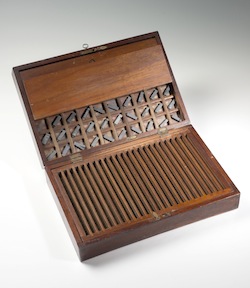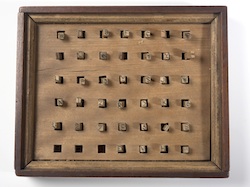Klein Type Box, c. 1840 (folding box, green felt backing to type board, 24 lines, lead type. With key and catches). Dimensions: 360 x 460 x 46mm. RNIB Collection Acc No: Mus/2.
Klein Type letters in display case, c. 1830. Dimensions: 210 x 265 x 40mm. RNIB Collection Acc No: Mus/4.
Klein type was an early popular embossed Roman alphabet originating from Vienna around 1807, named after its inventor, the educationalist Johann Wilhelm Klein, who introduced a personal writing frame in 1818. This later writing frame was designed to be portable: the pins stored in the drawer compartments of the box itself.
The pins shown next to it are part of a separate Klein writing set. Embossed writing practices were still held to be inferior by some sighted educators: Thomas Anderson, the director of the Edinburgh Asylum, said in 1837 that ‘stamping letter after letter by means of stamps, each having a letter of the alphabet upon it, has been gravely talked of as “writing”.’
References:
Thomas Anderson, Observations on the Employment, Education, and Habits of the Blind; with a Comparative View of the Benefits of the Asylum and School Systems (London: Simpkin, Marshall, and Co, 1837)
Object descriptions:
Object 21
This is a folding box made of mahogany wood. On the left hand side is a wooden frame consisting of 24 horizontal straight lines (running left to right), underneath which is a green felt backing lining a type board. On the right hand side are 30 compartments (10 rows of 3 columns) inside each of which is placed a lead type, the head consisting of sharp pins. The left and right side of the box are joined by two hinges placed towards the top and bottom edges. The far side of both left and right contain a key and clasping mechanism. [End description]
Object 22
This is an open box made of dark wood. Set into the inner frame about two centimetres deep are 42 rectangular lead types, with heads consisting of sharp pins. They are placed in evenly spaced squares cut into the wood (7 rows of 6 columns).

